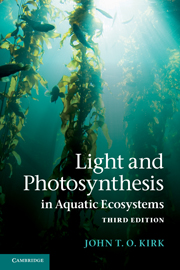Book contents
- Frontmatter
- Contents
- Preface to the third edition
- Part I The underwater light field
- Part II Photosynthesis in the aquatic environment
- 8 The photosynthetic apparatus of aquatic plants
- 9 Light capture by aquatic plants
- 10 Photosynthesis as a function of the incident light
- 11 Photosynthesis in the aquatic environment
- 12 Ecological strategies
- References and author index
- Index to symbols
- Index to organisms
- Index to water bodies
- Subject index
- Plate Section
9 - Light capture by aquatic plants
Published online by Cambridge University Press: 05 January 2013
- Frontmatter
- Contents
- Preface to the third edition
- Part I The underwater light field
- Part II Photosynthesis in the aquatic environment
- 8 The photosynthetic apparatus of aquatic plants
- 9 Light capture by aquatic plants
- 10 Photosynthesis as a function of the incident light
- 11 Photosynthesis in the aquatic environment
- 12 Ecological strategies
- References and author index
- Index to symbols
- Index to organisms
- Index to water bodies
- Subject index
- Plate Section
Summary
The collection of light energy for photosynthesis by aquatic plants is, as we have seen, carried out by the photosynthetic pigments. We have already examined the spectral absorption capabilities of each of the different classes of pigment. We shall now consider the light-harvesting properties of the complete photosynthetic system, with particular reference to the dependence of these on the specific combination of pigments present and, in the case of phytoplankton, on the size and shape of the cells or colonies.
Absorption spectra of photosynthetic systems
We might measure the absorption spectrum of, say, phytoplankton or a multicellular algal thallus, for a number of different reasons. We might seek information on what pigments are present. We might wish to compare the spectral position and shape of an in vivo absorption peak with those of the same peak in the isolated pigment with a view to assessing the extent to which the absorption properties are modified by binding to protein. We might want to know to what extent an alga is equipped to efficiently harvest light from the underwater radiation field in which it lives.
- Type
- Chapter
- Information
- Light and Photosynthesis in Aquatic Ecosystems , pp. 308 - 329Publisher: Cambridge University PressPrint publication year: 2010



